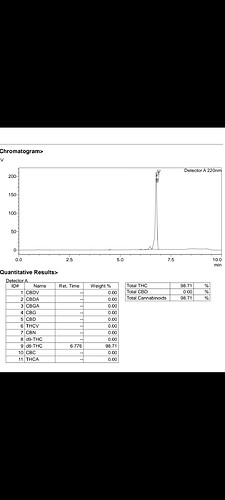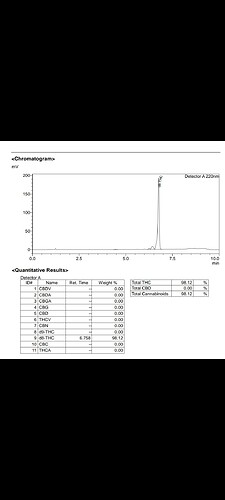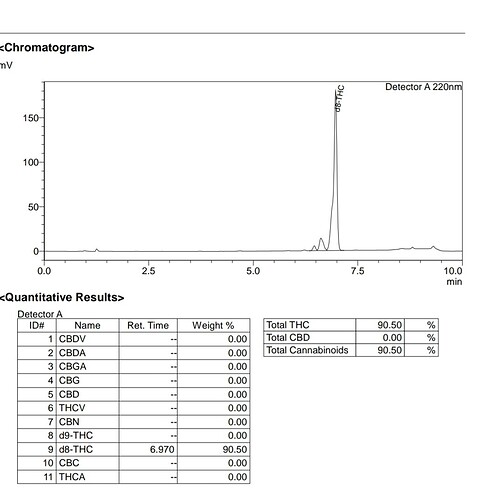How much for per KG?
I’m just glad you guys collaborated together and have created one of the most promising steps toward finally having compliant D8 that’s consistent and stable for the market props to both of you guys and will be watching closely and look forward to working together more on Creating safe stable consistent compliant products for people and our industry thank you @BluegrassCBD and @DUMPSTERFIREOG teamwork makes the dream work!
We feel left out…haha. This is a crazy biz.
No neutralization of some sort?
Yes bicarbonate and brine washes
@Dr_Jebril I “hear” you dont actually need to water wash with the ptsa method. Most ive talked to get same results whether water washing out not… typically can fraction everything out via distillation. I havent played with d8 in quite a while but when I did.
I was able to get graphs that all looked similar with 3 different catalyst. Phosphoric acid, hcl, ptsa
None of these three samples were water washed first just distilled… 2 of them never even used a solvent during the process. Reactor->WF
Awesome input @globtek33 thx
So you don’t get reactive distillation happening? Thats crazy
Maybe that’s the final kick to push few % higher… ![]()
Would be curious to see the intermediate outcome, straight from the synthesis pot.
@Globetek the data you show here show great similarity.
Still the resolution in not that great. And what is the LOQ ?
@Dr_Jebril typically it’s only a % to 3% difference from my rxn “crude” to after distillation. I’m sure if I dig deep enough back I could find a test on the rxn crude. Correct they were all done using different catalyst was just my way of showing there’s more then one way to come to the same outcome… I could figure out the loq… idk why it matters so much when I’m not trying to claim it to be compliant. We’ve all discussed the shoulder before
So different catalyst PLUS wash prior to distillation here, right ?
My question about the LOQ was regarding the “unknown” that are usually there (less after distillation of course). If the LOQ is > 0.5%, then most of them may be discounted. Taken together, this can make from 2 to 10% of the mass in fact (really depends if these are qualitative or quantitative data also).
But clearly, in term of outcome, the data you show here clearly indicate the main component is d8+d9, >80% for sure. (may also depends if we see full mixed distillate, OR a specific fraction…).
I have tested the rxn before distillation, sometimes it’s higher, sometimes its lower, but there’s variables involved. Best I’ve achieved is 90% after rxn and before distillation, highest after distillation was 95%, but have been unable to replicate that. I typically end up somewhere in the 80s, but trying to dial in distillation parameters to get the best separation between the D8 and unknowns is tricky, and trying to figure out where/when/why they get generated after the rxn. In theory, if washed so many times and ph is neutral, there shouldn’t be any reactive distillation occurring, but that’s the frustrating part about it is that it doesn’t add up much of the time.
Correct on those three samples all different catalyst not one was water washed. I’ll talk with my analytics department and find out LOQ.
As I’ve stated once before I don’t run the analytics and still learning about it!
From what I understand, on the business end, unless it’s tested by one of these labs your COA doesn’t mean squat to the law.
https://www.ams.usda.gov/rules-regulations/hemp/dea-laboratories
Only one of those labs is active on here ![]()
Yeah I also realized not all DEA registered labs are on that list and any registered lab would still suffice. Big whoops.
Still a good resource, lists always need updated.
The results from a DEA registered lab are just the same as a non DEA registered lab. The only values that mean anything to law enforcement are the ones generated in their lab.
DEA registration protects the lab and allows them to test hemp without worry that they could be charged for importing, exporting, etc. controlled substances. They are going to get massive amounts of hot samples and the DEA registration protects them from being convicted of any wrong doing when in possession of the samples. They are required to log any samples that test hot, store those samples in a locked safe, and then dispose of the samples by denaturing them.


